How to disassemble an exhaust fan in a bathroom: instructions for disassembling and cleaning the exhaust fan
The bathroom is one of those places in the apartment that simply needs high-quality ventilation. With its help, excess moisture that appears after taking a shower and specific aromas of cosmetics or detergents go into the shaft. Maintaining an optimal microclimate prevents the formation of fungus or mold, condensation on the faucet, mirrors or pipes, the gradual destruction of finishing materials and damage to furniture.
But natural ventilation of rooms is not always effective, is it? Therefore, setting the forced exhaust system sometimes it turns out to be the only way to eliminate steam and unwanted odors from the bathroom. However, long-term operation of the fan will inevitably lead to contamination of its components and a gradual decrease in performance. To improve the performance of the device, you need to know how to disassemble the hood fan, properly clean its parts and reinstall it.
In this material we will look at the structure of the hood, its step-by-step analysis, we will tell you how to quickly wash the device, mentioning why the draft in the bathroom can decrease even with a properly functioning hood.
The content of the article:
The structure and principle of operation of the hood
To properly disassemble and wash the hood in the bathroom, you should familiarize yourself with how it works and works. Most common models for installation in the bathroom there are axial (axial) fans, which are mounted on the wall in the place where the ventilation duct passes.
The axial type hood has an extremely simple device. The device captures air by rotating the axis on which the aerodynamic impeller with blades is fixed. Behind it is a compact motor, thanks to which the axis moves.
The impeller blades have a certain slope. It causes air to pass through the fan system, partially prevents the re-entrainment of the exhaust flow and contributes to the formation of pressure that entrains air into the ventilation duct.
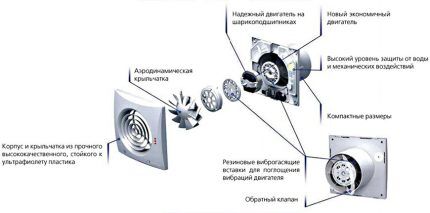
The fan blades are the most sensitive to contamination, since most of the dust and smoke particles settle on them if there is smoking in the room.
The place where the impeller is attached to the axle also needs thorough cleaning. In addition to removing debris, this area must be lubricated periodically. A couple of drops of special oil will be needed for the front and rear bearings located near the motor.
You can tell that it’s time to dismantle and wash the hood by visual inspection by shining a flashlight behind the outer grille.
The following signals may indicate the need for cleansing:
- increase in noise level, generated by the fan during operation;
- reduction in traction due to a decrease in hood performance.
All these facts indicate that the rotation speed of the aerodynamic impeller has dropped, so the hood needs to be disassembled, scheduled cleaning and diagnosis of possible faults.
Subtleties of disassembling and cleaning the hood
In order to dismantle the hood, it is not necessary to invite a specialist. First, you need to find in the user manual an item on how to remove the front cover of a bathroom fan, and after studying the instructions, proceed to subsequent disassembly and independent maintenance of the device.
Step #1 - turn off and remove the hood
Removal of the device begins with de-energizing the line from which the hood is powered. This is especially important if the fan is directly connected to light switch and begins its work simultaneously with the lighting source in the bathroom.
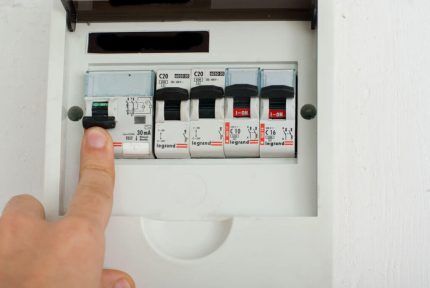
The hood cover itself is often attached to several self-tapping screws, which are placed at the end of the body for the aesthetics of the design. Less often, it can be equipped with grooves, with the help of which it is fixed.
After removing the cover there are several steps to follow:
- Unscrew the screws that secure the device in the ventilation hole.
- Pry the housing around the perimeter, disconnecting it from the wall if it was attached with glue.
- Carefully remove the device and disconnect its wires from the power cable.
If the hood was working before dismantling, you need to let it cool, after which you can disassemble the fan.
Step #2 - disassembly and maintenance
After the fan has cooled, you must carefully disassemble the main components in order to clean and lubricate the necessary parts.
To do this you need to perform the following steps:
- Remove the impeller wheel. Most often it is attached to the shaft using the collet method. To disconnect the part, you just need to turn the fastening nut.
- Carefully remove the motor, first disconnecting the terminals. The motor itself is usually attached to the housing using two screws.
After this, you can begin to clean the parts and lubricate certain components with machine oil: bearings, axles. The easiest way to remove dust from areas that cannot be washed is to use a soft, medium-sized brush.
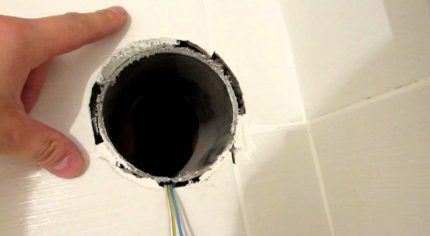
The fan impeller, outer cover and mesh that protects against the penetration of insects from the shaft must be thoroughly rinsed with water. It is advisable not to use detergents, as they can be quite aggressive towards plastic.
The optimal cleaning agent would be regular laundry soap without adding bleach. It produces abundant dense foam, which can effectively remove dirt deposits from the hood parts.
Then you have to lubricate the main components of the hood. For spot application of lubricant, it is most convenient to use a syringe with a thin needle. Rotate the turning parts to distribute the oil evenly.
Before performing installation again, you need to thoroughly dry all components and remove excess oil by blotting the desired areas with a napkin.
Step #3 - reassembly and installation of the device
Assembling the hood also does not require much knowledge.Next, we’ll look at how to reassemble the built-in fan in the wall after we’ve managed to clean it.
Restoring structural integrity involves several key points:
- installing the motor into the housing and then connecting the terminals;
- securing the aerodynamic impeller to the axis.
You need to be especially careful when fixing the impeller: if you install it backwards, you can provoke the appearance of reverse draft, due to which contaminated moist air will not leave the bathroom.

All the necessary information about fan installation contained in the instructions for the device.
Typically, after assembling the main part of the structure, the user needs to:
- coat the back of the case with Liquid Nails glue;
- place the hood in the hole made in the shaft;
- screw all the screws around the perimeter of the body;
- connect the power wires;
- install a mosquito net;
- fix the hood cover with bolts if the design does not have grooves.
After installation, you need to make sure that the device is working - check that it turns on and is able to create sufficient traction.
Typical causes of decreased cravings
If, after you managed to wash the hood in the bathroom, its performance has not increased to nominal, it is worth identifying the reasons why the device is not working properly.
In addition to normal wear and tear on equipment, many different factors can affect suction levels. But most often the root of insufficient air exchange lies in decreased draft.So why does a serviceable and clean forced air hood fail to remove moist air?
Reason #1 - poor air exchange
To exhaust air flows, a wall hood needs an influx of fresh air. To do this, there should be special openings with grilles at the bottom of the door, through which air from other rooms will enter the bathroom.
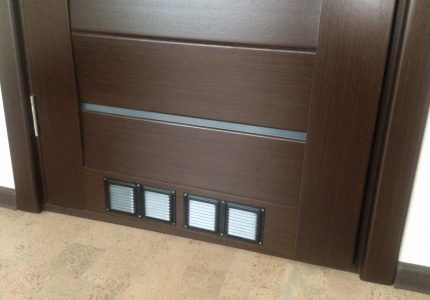
If there is no opportunity or desire to replace the interior door, you should leave it ajar more often, widen the opening between the door leaf and the door frame, or cut the ventilation holes yourself.
Installation of plastic windows, careful insulation of walls and reliable entrance doors with good insulation significantly prevent the penetration of street air into the home. Therefore, even in winter, it is important to periodically ventilate all rooms. And also put windows with supply valve.
Reason #2 - clogged ventilation ducts
If the ventilation shaft is clogged with contaminants or blocked, even a powerful forced-air exhaust will not cope with its tasks. Therefore, it is necessary to check the presence of natural ventilation. If the built-in hood does not have a check valve, this can be done in the simplest way. Such testing can be carried out in the cold season, since in the summer, when the air temperature indoors and outdoors is too high, a sufficient pressure drop will not be created.
After turning off the fan, provide fresh air by opening the apartment windows and the bathroom door. Place a napkin against the hood grille. If a piece of light paper is attracted to the hole, then everything is in order with the functioning of the ventilation. And if there is no draft at all, you need to contact the management company, after which a special service will check the ventilation ducts and repair them cleaning.
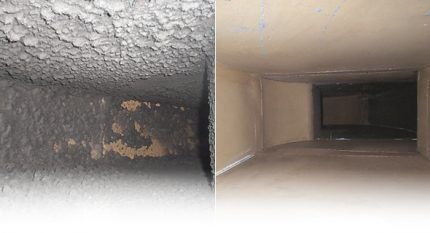
Additionally, you can determine the presence of traction by the condensation that falls on the mirror after taking a bath. If the steam quickly disappears after opening the doors to the room, it means that natural ventilation is functioning properly.
Reason #3 - installation of powerful hoods by neighbors
If neighbors living on the floors below install too powerful fans, the draft in the duct may drop significantly due to the formation of a rapid air flow. In some cases, a phenomenon may occur reverse thrust, in which air from the bathrooms of other residents will be blown into the rooms on the floors above.
To get rid of these problems, you should either negotiate with your neighbors or install a more powerful forced air removal device.
However, the latter option risks creating inconvenience for the residents above and may require widening the hole in the wall leading to the shaft. This is due to the fact that the nominal performance of the exhaust fan is also affected by the diameter of the duct inlet.
Reason #4 - presence of a check valve
To prevent unpleasant odors from the neighbors below from entering the bathroom, users often supplement the design of the wall-mounted exhaust system with a special part - check valve. It cuts off air flow from the ventilation duct.
But in the absence of normal inflow and installation of an unsuitable hood, it will completely block the air duct, thereby depriving the room of a natural path for air extraction
Conclusions and useful video on the topic
The detailed process of removing the hood cover and the amount of dirt that has settled on the parts is filmed by the author of the video below:
The author of the following video explains how to properly install a hood on a bathroom wall if the hole leading into the ventilation duct is significantly larger than the diameter of the fan inlet:
Detailed disassembly and repair of the hood was demonstrated by another author:
A properly functioning hood in the bathroom is the key to maintaining a normal microclimate throughout the entire home, since the presence of excess moisture in one room will inevitably affect the overall level of humidity in the apartment.
Like any other device, an exhaust fan requires periodic maintenance and cleaning. Dismantling, disassembling, cleaning and reinstalling a wall-mounted hood does not take much time and does not require special knowledge. However, if after performing the planned procedures the fan still does not provide proper air exchange, you should pay attention to the correct functioning of natural ventilation.
Have you recently disassembled the fan and cleaned it of dirt? Share your experience with other users, tell us which area of work was the most difficult for you.If you still have questions about the topic of the article, ask our experts - the feedback form is located below.




How to disassemble a motor in order to rewind a burnt winding?